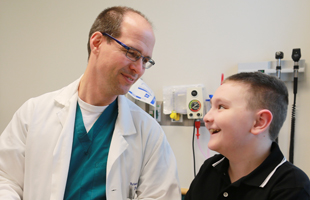Unique Collaborations Improve PUV Care, Accelerate Research

Children with posterior urethral valve (PUV) disorder face myriad complications affecting renal function, urination, fertility, mental health and quality of life. Multidisciplinary care is essential to their well-being, but too often the care they receive is compartmentalized, and treatment protocols vary widely. This results in costly and ineffective therapy with poor clinical outcomes: Historically, over 50% of affected patients progress to end-stage renal disease and renal transplantation.
Cincinnati Children’s offers a different approach with its new PUV program. Established in 2018, the program provides multidisciplinary care from a team of specialists that includes providers from pediatric urology, nephrology, surgery and transplant surgery. It is evolving to include other specialties such as neonatology and behavioral medicine.
“Our goal is to take a holistic, family-centered approach to preserving renal and bladder function, while not losing sight of issues such as nutrition, growth and development,” says Pramod Reddy, MD, director of the Division of Urology at Cincinnati Children’s. “We want to empower families and help patients be as independent as possible so they can live their lives to the fullest and not be held back by the sequelae of PUV.”
The program’s priorities include:
- Coordinating medical management of patients with PUV disorder and mitigating complications and the risk factors for progression of kidney disease while reducing the cost of care
- Optimizing nutrition, growth and development for patients with chronic kidney disease
- Helping patients and families accept the diagnosis, adhere to the treatment plan and experience an improved quality of life
Research
Researchers at Cincinnati Children’s are studying ways to improve diagnostic tools and identify biomarkers of renal and bladder injury associated with PUV disorder. The hospital is one of five in the Midwest that is part of a new research consortium called the Pediatric Urology Midwest Alliance (PUMA). The group’s first paper, published in Pediatrics in May 2019, was a multisite pediatric urology study focusing on PUV. Brian VanderBrink, MD, a pediatric urologist at Cincinnati Children’s, was the study’s senior author.
The researchers reviewed medical records from 274 infants diagnosed with PUV and treated at any of the five participating hospitals over a 20-year period. They aimed to identify clinical variables associated with the risk of renal replacement therapy and clean intermittent catheterization. Results showed that the risk of both outcomes increased with age, and that serum nadir creatinine (SNC1) levels in the first year of life strongly predicted the need for renal replacement therapy.
These results provide the foundation for future PUMA initiatives to risk-stratify patients with PUV, report outcomes and implement interventions early in life to positively affect patient outcomes, VanderBrink says. “The study’s results created baseline values for PUMA and served as a springboard to establish consensus on a treatment algorithm for newborns diagnosed with PUV treated at PUMA institutions,” he explains. “This type of collaboration will help us improve family counseling and provide more risk-based screening and intervention strategies for higher-risk patients.”

